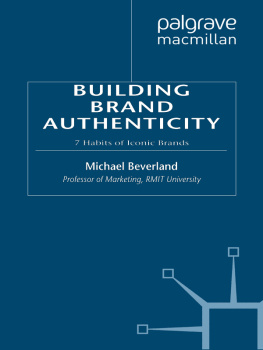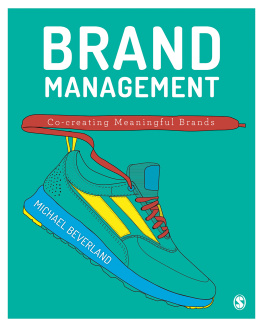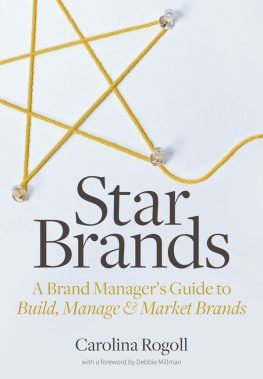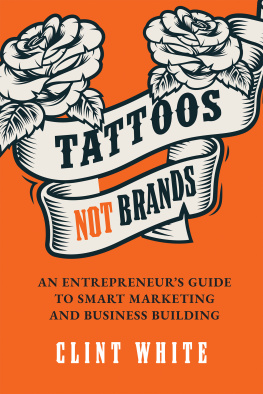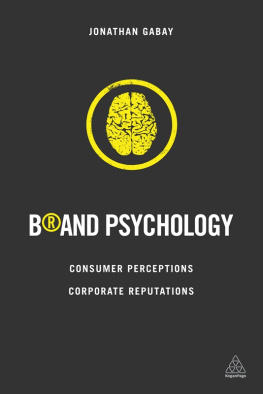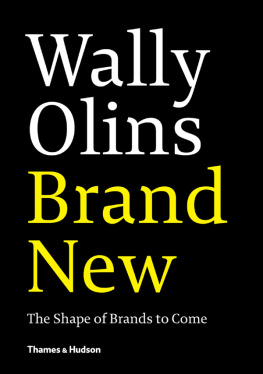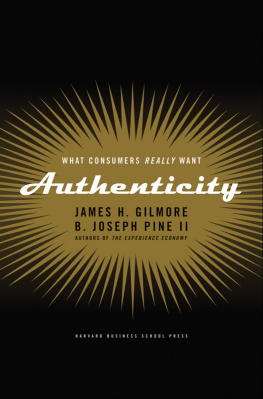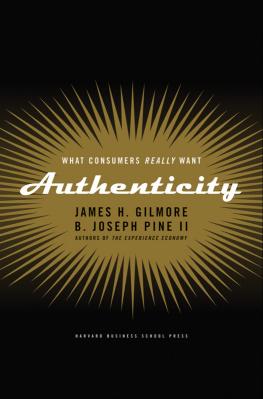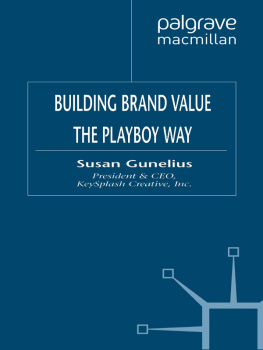BUILDING BRAND AUTHENTICITY
BUILDING
BRAND
AUTHENTICITY
7 Habits of Iconic Brands
Michael Beverland
Professor of Marketing, RMIT University


Michael Beverland 2009
All rights reserved. No reproduction, copy or transmission of this publication may be made without written permission.
No portion of this publication may be reproduced, copied or transmitted save with written permission or in accordance with the provisions of the Copyright, Designs and Patents Act 1988, or under the terms of any licence permitting limited copying issued by the Copyright Licensing Agency, Saffron House, 610 Kirby Street, London EC1N 8TS.
Any person who does any unauthorized act in relation to this publication may be liable to criminal prosecution and civil claims for damages.
The author has asserted his right to be identified as the author of this work in accordance with the Copyright, Designs and Patents Act 1988.
First published 2009 by
PALGRAVE MACMILLAN
Palgrave Macmillan in the UK is an imprint of Macmillan Publishers Limited, registered in England, company number 785998, of Houndmills, Basingstoke, Hampshire RG21 6XS.
Palgrave Macmillan in the US is a division of St Martin's Press LLC, 175 Fifth Avenue, New York, NY 10010.
Palgrave Macmillan is the global academic imprint of the above companies and has companies and representatives throughout the world.
Palgrave and Macmillan are registered trademarks in the United States, the United Kingdom, Europe, and other countries.
ISBN-13: 978-0-230-58031-2
This book is printed on paper suitable for recycling and made from fully managed and sustained forest sources. Logging, pulping and manufacturing processes are expected to conform to the environmental regulations of the country of origin.
A catalogue record for this book is available from the British Library.
A catalog record for this book is available from the Library of Congress.
10 9 8 7 6 5 4 3 2 1
18 17 16 15 14 13 12 11 10 09
Printed and bound in Great Britain by CPI Antony Rowe, Chippenham and Eastbourne
To Emma
LIST OF FIGURES AND TABLES
Figures
1.1 Building brand authenticity
1.2 Zippo has long been a US soldiers most desired possession a relationship honoured in this design
2.1 Authoring brand meaning
2.2 Authenticating brands
3.1 Bruichladdich's Weapons of Mass Destruction (WMD II)
3.2 Stories are at the heart of whisky producer Bruichladdich
4.1 Altoids packaging appears old world and amateurish when compared to the brands plastic, manufactured competitors thats part of Altoids' charm
4.2 Altoids advertisements are as collectible as their tins. The ads reinforce the brands playful, irresistible, deviant nature
4.3 The instantly recognizable face of Dilmah Teas Merrill J. Fernando
4.4 The sign says it all Virgin gyms encapsulate Richard Bransons laidback fun image (unlike all those other corporate gyms)
6.1 Eagerly awaited by collectors, W. Britains return to the Delhi Durbar range kicks off with this lovingly crafted, and carefully researched, Jaipur elephant
7.1 Phil and Teds Inline Buggy a product improved through direct feedback from staff-as-parents
7.2 Hans Becks Playmobil figures were developed after observing how children draw faces and figures
7.3 Dyson married cutting edge technology and design with tradition in the firms new take on the washing machine the Contrarotator
7.4 Now a staple of kitchens and airports, the Dyson Airblade is another example of how the firm constantly challenges traditional thinking in designs
10.1 Thousands visit the Zippo Visitors Centre every year
Table
3.1 Ten stories behind authentic brands
ACKNOWLEDGEMENTS
No book about being true to oneself can fail to acknowledge the many people that have helped me along the way. First and foremost, I'd like to thank my co-authors who have played a critical role in honing some of the ideas covered here. A big thank you to my main partner in crime, Francis Farrelly (Monash University), as well as Sonia Dickinson-Delaporte and Julie Napoli (Curtin University), Mike Ewing (Monash University), Adam Lindgreen (Hull University Business School), Pascale Quester (University of Adelaide), and Michiel Vink for their respective contributions to various articles on authenticity. Second, a big thanks to Emily Chung and Kay Laochumnanvanit for helping with consumer data collection. Third, a big thanks to all the supportive editors of various journals that have nursed my (often rough) ideas through the review process. Thanks to John Deighton and Eric Arnould (Journal of Consumer Research), Candace Jones, N. Anand, and Jos Luis Alvarez (Journal of Management Studies), Barry Babin (Journal of Business Research), Russell Laczniak, Tom Duncan, Don Schultz, Charles Patti, and Marla Royne (Journal of Advertising), Catherine Dalton (Business Horizons), Nick Lee (European Journal of Marketing), Matt Coney (Idealog), Abbie Griffin (Journal of Product Innovation Management), and Thomas Walton (Design Management Review) for their patience, support, and insights (and acceptance). Fourth, thanks also to all the anonymous reviewers that provided constructive insights on each of my papers. Throughout the development of my ideas, a number of people have provided encouragement and critical insights that have proved very useful. These include Linda Price (University of Arizona), Tandy Chalmers (Queen's University), Mark Ritson (Melbourne Business School), Richard Elliot (University of Bath), Kelly Tian (University of New Mexico), Steven Kates (Simon Fraser University), Mark Uncles (University of New South Wales), Carla Taines (University of Melbourne), Peter Danaher (Melbourne Business School), Tim Fry and Mike Reid (RMIT University), and Steve Charters (Reims Management School).
This book would not have been possible without generous funding. In many cases grant bodies were asked to provide funds for what seemed, on the face of it, rather questionable projects such as conducting research on luxury wineries in France. Without the support of various reviewers and chairpersons, the research necessary to bring these ideas to life would have been impossible. Thanks therefore to the Faculty of Business and Economics Research Committee at Monash University, the Faculty of Economics and Commerce Research Committee at University of Melbourne, the School of Economics, Finance and Marketing Research Committee at RMIT University, the Australian Research Council (DP0985178 & DP0664943), and Phil Bretherton who as Head of School at Unitec, Auckland signed off on many research requests that ultimately generated case data for this book.
Although funds were critical, this book would never have appeared were it not for the informants. There are too many to thank, and many more gatekeepers and connectors whose names I've forgotten who helped secure me interviews with busy people (especially in France). However, I'd like to thank the following people for providing me with approval to use the photographs in the book: Anton Brown (Virgin Active Australia), Matthew Parkin (Morgan Motor Co), Mark Reynier (Bruichladdich), Richard Walker (

